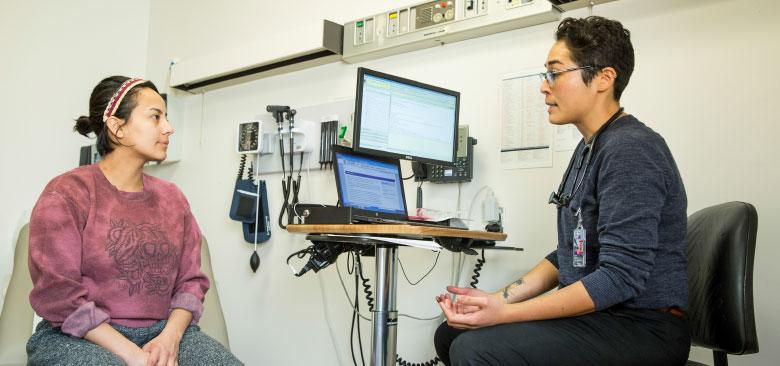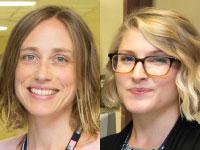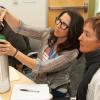
Nurse practitioner resident Haruka Kelley (right) with a patient at the VA women’s clinic. (Photos by Elisabeth Fall.)
Seeking to Spread and Standardize NP Residencies
Nurse practitioner (NP) residency programs – also known as NP fellowships – appear to be on the rise in the United States. Most states now offer such programs in at least one setting. In California, the UC San Francisco School of Nursing is among those leading the way, with a diabetes fellowship program, as well as primary care and psychiatric/mental health nurse practitioner (PMHNP) residencies at the San Francisco VA Health Care System (SFVAHCS).
 Anna Strewler “NP residency programs are a model for how to bridge the gap between academic training and a professional career,” says NP Anna Strewler, who co-directs the Center of Excellence in Primary Care Education (CoEPCE) at the SFVAHCS and is a graduate of the NP residency there. “They are neither common nor mandated, but they represent a needed option for transition to practice in many settings and for many learners.”
Anna Strewler “NP residency programs are a model for how to bridge the gap between academic training and a professional career,” says NP Anna Strewler, who co-directs the Center of Excellence in Primary Care Education (CoEPCE) at the SFVAHCS and is a graduate of the NP residency there. “They are neither common nor mandated, but they represent a needed option for transition to practice in many settings and for many learners.”
She notes the SFVAHCS is working toward accreditation of both of its NP residencies through a new accreditation program offered by the National Nurse Practitioner Residency & Fellowship Training Consortium.
“NP residency programs are diverse at this point, and accreditation can bring more standardization,” says Strewler. “Going through accreditation also forces us to do a self-study on how we’re doing – whether we’re meeting our goals and whether our competencies are valid and well-supported.”
The Primary Care Residency
The self-study can drive important change. Based on specialty-specific evaluations by residents, Strewler’s team is working with specialty clinics to standardize the competencies for each rotation. The team is also soliciting input from its former residents to create the ideal balance among training in clinical practice, quality improvement, leadership, education and interprofessional and patient-centered communication.
 Rebecca Conroy While creating that balance is an ongoing process, the program’s former residents have no doubt about its value. After completing the School’s Adult-Gerontology Primary Care Nurse Practitioner (AGPCNP) program – including Education in Patient Aligned Care Teams (EdPACT), a collaboration among the VA, the UCSF schools of medicine and nursing and the UCSF Office of Graduate Medical Education – Rebecca Conroy completed her NP residency at the SFVAHCS in 2015. She moved immediately into providing home-based primary and palliative care in the UCSF Division of Geriatrics Housecalls Program. There, she not only sees patients, but also precepts students from the School.
Rebecca Conroy While creating that balance is an ongoing process, the program’s former residents have no doubt about its value. After completing the School’s Adult-Gerontology Primary Care Nurse Practitioner (AGPCNP) program – including Education in Patient Aligned Care Teams (EdPACT), a collaboration among the VA, the UCSF schools of medicine and nursing and the UCSF Office of Graduate Medical Education – Rebecca Conroy completed her NP residency at the SFVAHCS in 2015. She moved immediately into providing home-based primary and palliative care in the UCSF Division of Geriatrics Housecalls Program. There, she not only sees patients, but also precepts students from the School.
“It’s hard for me to imagine my current career without the EdPACT and residency programs,” she says. “In the residency, I could really focus so much of my efforts on being a brand-new NP while having support and mentors available, engaging in quality improvement work, teaching NP students and having case conferences and didactics – you learn everything at a deeper level.”
Such intensive training gave Conroy confidence as she plunged into seeing patients independently and consulting with her professional colleagues from other disciplines in the Housecalls practice. “We are also constantly doing mini QI [quality improvement] projects as we examine how to efficiently expand the number of patients we see – and that was something I learned a lot about during the residency,” she says.
The Psychiatric/Mental Health Residency
Established in 2016, the PMHNP residency at the SFVAHCS is the first of its kind in California. It reflects the SFVAHCS’s commitment to NPs generally and PMHNPs more specifically. In its first year, the residency helped PMHNPs at the SFVAHCS exceed the VA’s national benchmarks for productivity – a measure of workload based on complexity and volume – and enabled the SFVAHCS to offer a third again more visits with veterans than it had before the residency.
“This creates more access and frees up our faculty to see more veterans,” says Mary Ann Nihart, interim associate director for patient care and nursing services at SFVAHCS, who co-wrote the original grant for the residency along with the School’s Bethany Phoenix.
A 40-hour-a-week commitment, residents’ clinical time is enhanced by didactics and supervised discussions on many of the challenges PMHNPs face when working with veterans. Like their primary care counterparts, the residents also engage in leadership training and professional development, including having to complete a quality improvement capstone project. The residency also emphasizes a holistic approach to mental health care, which includes a strong awareness of how to work in teams.
 Bethany Sullivan (left) and Katelyn Brady Bethany Sullivan, who completed the program in 2017, appreciated the exposure to a number of clinical situations, having worked in clinics ranging from substance abuse, mood disorders and rehabilitation through psychiatric outpatient and an access center.
Bethany Sullivan (left) and Katelyn Brady Bethany Sullivan, who completed the program in 2017, appreciated the exposure to a number of clinical situations, having worked in clinics ranging from substance abuse, mood disorders and rehabilitation through psychiatric outpatient and an access center.
“It’s a great way to start a career, and in general, I’m loving it; it’s exceeded my expectations,” said Katelyn Brady, in a previous Science of Caring article on the residency. Brady was also among the first PMHNP postgraduate residents and is now one of those with a joint faculty appointment at the School and the SFVAHCS. “Every new provider has that sense of being a fraud at first, even after graduating from a top-tier school like UCSF. I chose to complete this residency not because I do not feel prepared to practice as an NP, but for the purpose of being more prepared.”
“Residencies are so important,” says Conroy. “I hope they become standard for NP education in the future.”



